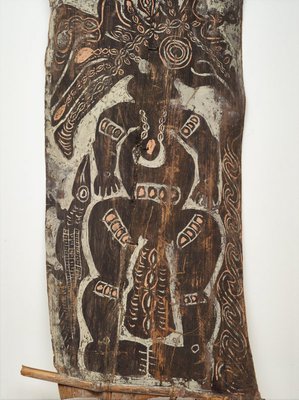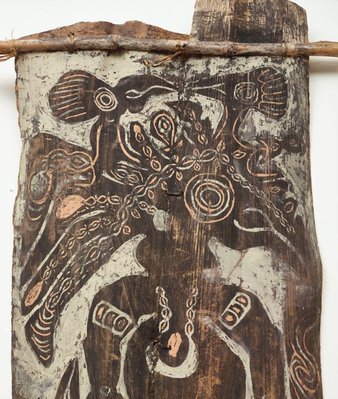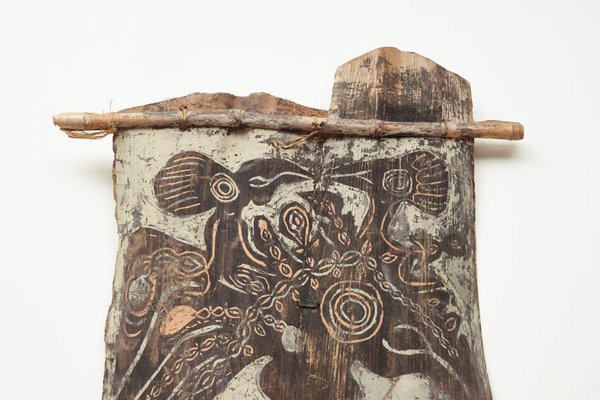Title
Painting from ceremonial house ('deman' spirit with two birds and lizard)
mid 20th century
collected 1965
Artist



-
Details
- Other Titles
- Bark painting, human figure with a bird's head and two other birds; lizard to one side
Figure, bird headed and surmounted by birds - Place where the work was made
-
Kambot Village
→
Keram River
→
Lower Sepik River
→
East Sepik Province
→
Papua New Guinea
- Cultural origin
- Ap Ma people
- Dates
- mid 20th century
collected 1965 - Media category
- Painting
- Materials used
- sago palm petioles, bamboo, natural pigments
- Dimensions
- 162.0 x 67.0 cm
- Credit
- Purchased 1965
- Location
- Not on display
- Accession number
- 373.1994
- Copyright
- Artist information
-
Ap Ma people
Works in the collection
- Share
-
-
About
Kambot village lies on the Keram River, a tributary of the lower Sepik. Kambot was first visited by Europeans during a German-led 1912–13 Sepik expedition and its spectacular ceremonial houses featured in the American film 'Jungle islands', shot during the 1928–29 expedition led by Cornelius Vanderbilt Crane for the Field Museum in Chicago. Set high on pilings above the flood plains, the houses' immense overhanging gables – said to resemble the open jaws of a crocodile – were adorned with paintings of spirits from the Kambot pantheon, including the paramount ancestor Mopul.
Made from the flattened lower leaf stalks of the sago palm, painted panels – 'panggal' in Pidgin – are sewn together and carefully prepared with a black undercoat. Artists then draw lines with white clay pigment and forms are filled with yellow and orange ochres.
[entry from Exhibition Guide for 'Melanesian art: redux', 2018, cat no 18]
-
Exhibition history
Shown in 2 exhibitions
Aboriginal and Melanesian art, Art Gallery of New South Wales, Sydney, 19 Oct 1974 -
Melanesian art: redux, Art Gallery of New South Wales, Sydney, 17 Nov 2018–17 Feb 2019
-
Bibliography
Referenced in 2 publications
-
Tony Tuckson, Art Gallery of New South Wales Quarterly, 'Some Sepik River art from the collection', pg. 666-679, Sydney, Apr 1972, 667, 670, 674 (illus.). plate no. 3
-
Tony Tuckson, Aboriginal and Melanesian art, Sydney, 1973, 43. cat.no. 24
-


